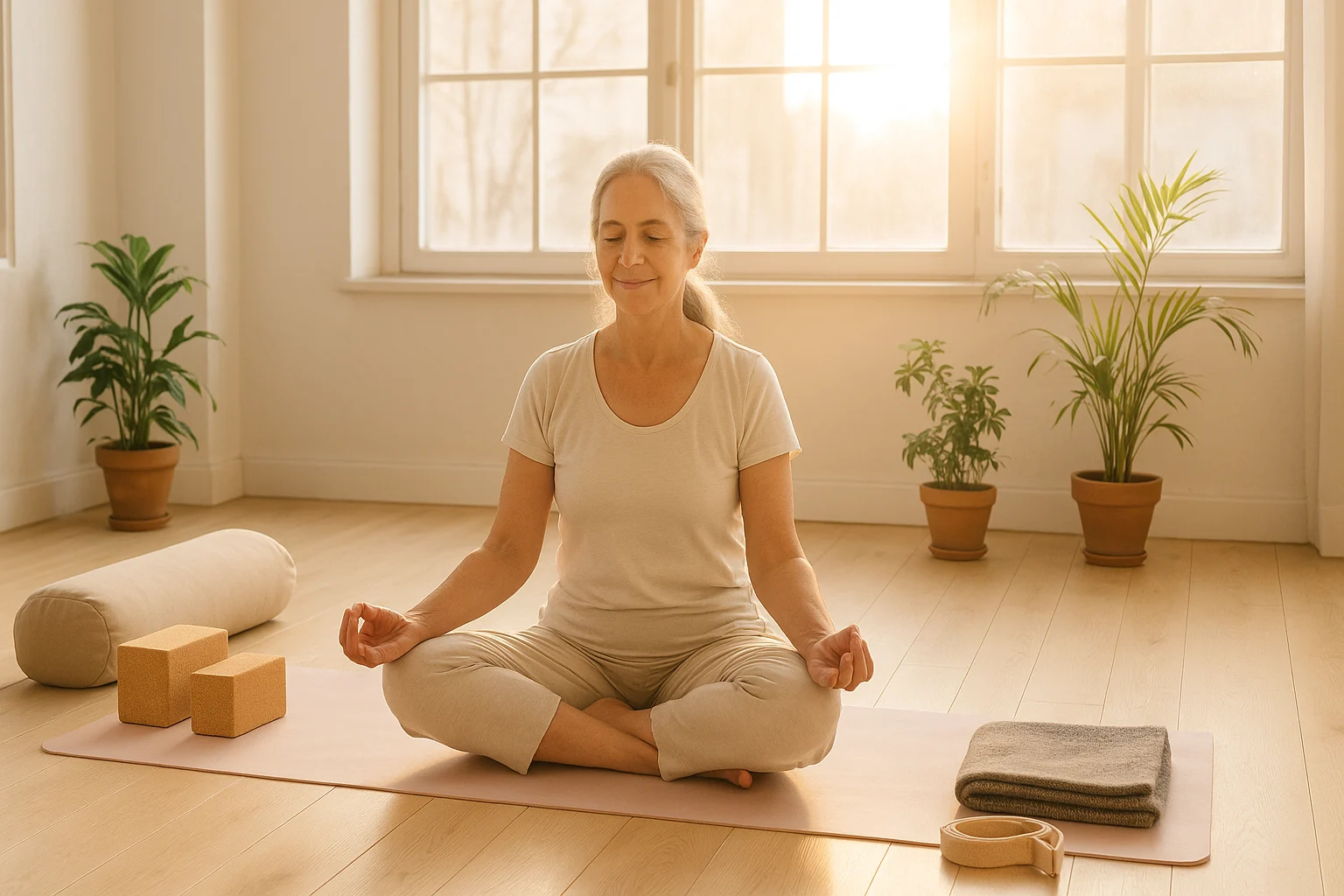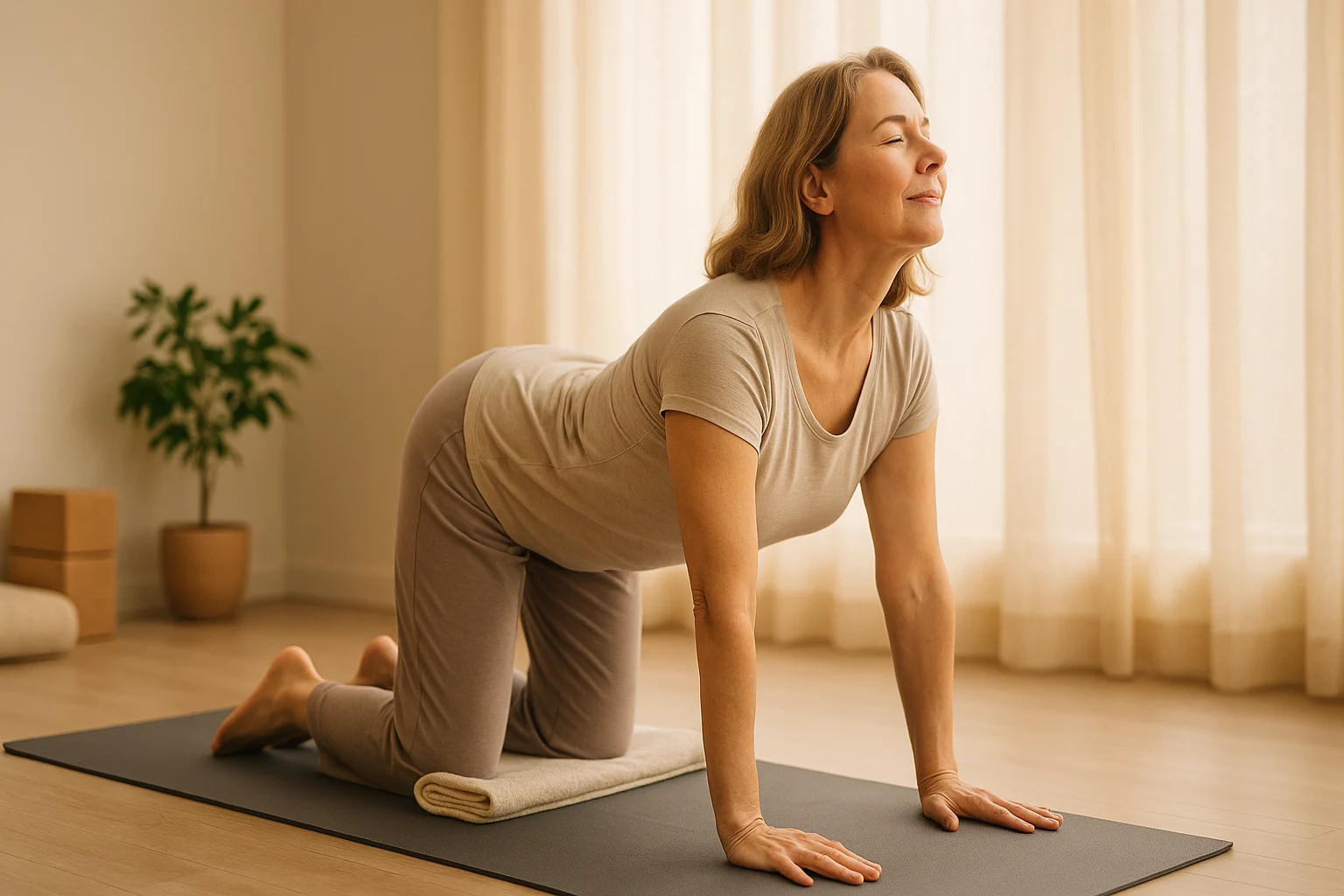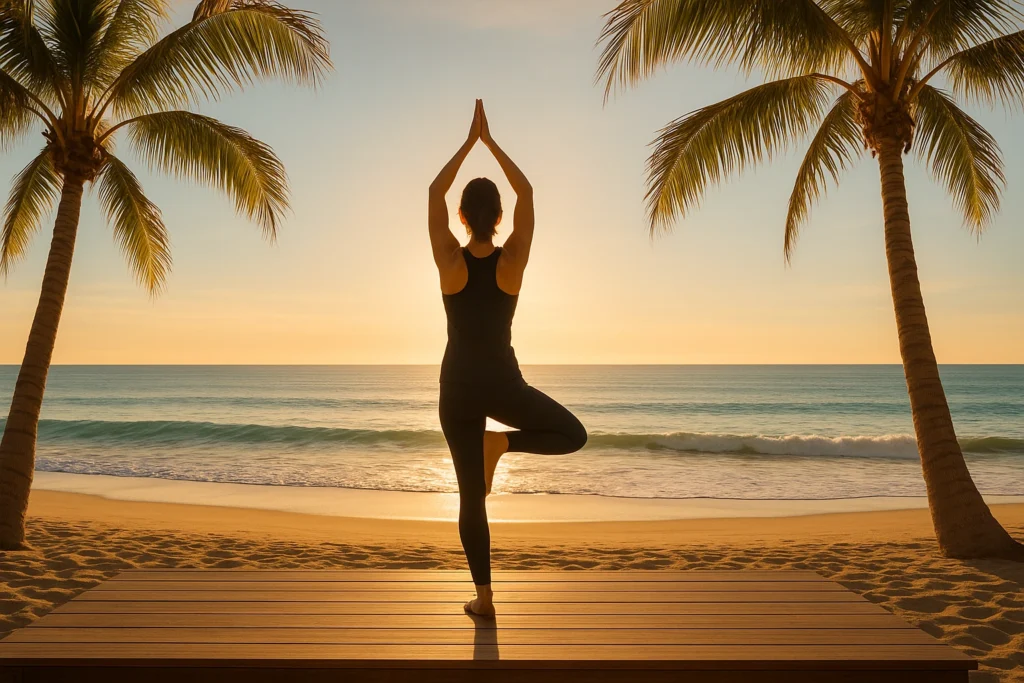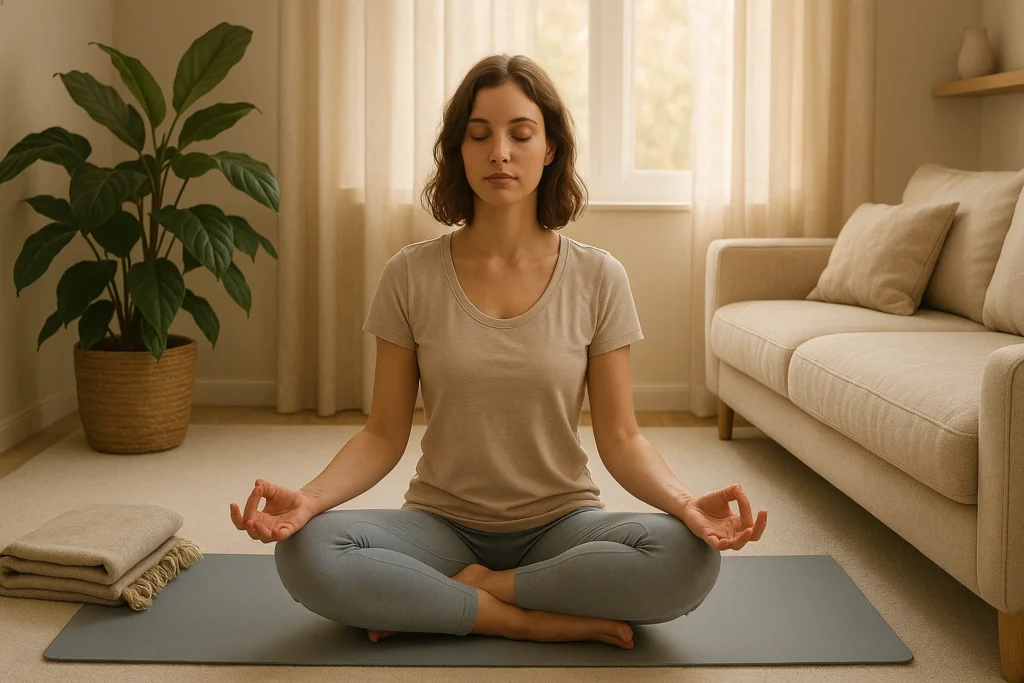
Struggling with stiffness from sitting or aging? Gentle yoga sequences can help you loosen up and feel more at ease—without pushing hard. If you want a simple plan to follow, check out our complete Yoga Flexibility Guide—it’s packed with step-by-step routines, prop tips, and ways to make progress over a few weeks. It’s beginner- and senior-friendly, and the poses keep things simple and enjoyable. Ready to start? ✨
Track Your Flexibility Now!This page contains paid/affiliate links. As an Amazon Associate we earn from qualifying purchases, and we may earn commissions from other partners—at no extra cost to you. Links marked with ‘#ad’ are affiliate links, meaning we may earn a commission at no extra cost to you. Learn more.
Table of Contents
- Why Choose Gentle Yoga for Flexibility?
- Understanding Flexibility: Beyond Touching Your Toes
- Essential Props for Gentle Yoga Routines
- The Power of Breath in Gentle Yoga Practice
- Gentle Flows for Hips, Hamstrings, Shoulders & Spine
- A Sample Full Gentle Yoga Routine for Flexibility
- Your Flexibility Comfort Tracker
- Gentle Yoga Practice Tips
- Frequently Asked Questions
- Embrace Your Journey to Greater Ease
Why Choose Gentle Yoga Sequences for Flexibility?
Most of us sit more than we’d like—tight hips, grumpy hamstrings, rounded shoulders. Flexibility also fades with age, so everyday moves can feel harder. Fortunately, gentle yoga flows can be a helpful approach.
Unlike vigorous styles, gentle yoga routines focus on:
- Slow, mindful movements: Poses are held longer, allowing your body to release tension gradually while your mind relaxes. No rush!
- Accessibility: Poses adapt to various body types and conditions, meeting your body where it is today.
- Reduced injury risk: Moving slowly—and using props—helps you avoid overstretching. Think steady, not speedy.
- Deep relaxation: Breath-focused sessions can calm your nervous system and take the edge off stress.
- Improved body awareness: You’ll start noticing small signals—what your body needs and where to ease off.
“Think of gentle yoga as a chat with your body—not a contest. Aim for ease; skip the forcing.”
For beginners, a beginner yoga flow builds a strong foundation, teaching alignment and breath awareness. For seniors, they support joint health, balance, and mobility, enhancing quality of life. Even seasoned yogis benefit from their restorative qualities. To learn more about yoga’s benefits, check out this research on yoga’s benefits.
Understanding Flexibility: Beyond Touching Your Toes
Flexibility isn’t only about touching your toes—it’s about moving your joints comfortably and without stiffness. Specifically, it involves:
- Muscle elasticity: How well muscles lengthen and shorten.
- Connective tissue health: The suppleness of ligaments, tendons, and fascia.
- Joint mobility: Healthy, lubricated joints.
Improving flexibility through gentle yoga practices eases daily tasks like bending or reaching, reduces soreness, prevents injuries, and improves posture. If you’re new to yoga, try an easy yoga for newbies routine to start safely and build confidence. You can even start with a short beginner yoga flow to get comfortable with movement.
Essential Props for Gentle Yoga Sequences & Routines
Props aren’t a sign of weakness—they’re smart tools that enhance your gentle practice. They provide support, deepen stretches safely, and increase comfort. For example, a non-slip yoga mat ensures stability during poses. Here’s a quick guide:
| Prop Name | What It Is | How It Helps for Flexibility | My pick |
|---|---|---|---|
| Yoga Mat | A sticky, padded surface. | Provides grip and cushioning for comfort on hard floors. | Buy on Amazon |
| Yoga Blocks | Firm foam, cork, or wood blocks. | Bring the floor closer in forward folds, support head/hips, or deepen stretches. | Buy on Amazon |
| Yoga Strap | A long, sturdy fabric strap with a buckle. | Extends reach for hamstrings, aids gentle traction, or assists in binding poses. | Buy on Amazon |
| Bolster | A firm, cylindrical or rectangular pillow. | Supports restorative poses, elevates spine/hips, and opens the chest. | Buy on Amazon |
| Blanket | A folded, thick blanket. | Cushions knees or hips, supports the head, or provides warmth during relaxation. | Household swap works great |
The Power of Breath in Gentle Yoga Practice
Your breath is your anchor during practice. It links your mind and body, helping your nervous system downshift. For example, slow, deep breathing can activate the body’s relaxation response and may help reduce stress. For more techniques, try this calming breathwork guide.
Try these techniques:
- Ujjayi Breath: Inhale through your nose for 4 counts, exhale for 6, creating a soft, oceanic sound in your throat. This calms and regulates energy.
- Breath-Synchronized Movement: Move with your breath—inhale to lengthen, exhale to deepen a stretch. It’s like a moving meditation.
- Mindfulness: Notice sensations without judgment. Feel tightness, release, and areas to soften.
Before starting, sit or lie down, close your eyes, and take 10 slow breaths. This prepares you for your session.
Gentle Yoga Sequences & Flows for Hips, Hamstrings, Shoulders, and Spine
These flows target stiff spots like hips and shoulders. Move slowly, tune into your body, and skip anything that hurts.
Hip Release Yoga Flow: Gentle Sequence 1
Tight hips affect your back, knees, and posture. This soothing yoga practice opens hip flexors and outer hips. For related hip issues, explore yoga for piriformis relief.
Supine Figure-Four Stretch (Eye of the Needle Pose)
Benefit: Stretches outer hip and glutes.
How-To:
- Lie on your back, knees bent, feet flat, hip-width apart.
- Place your right ankle on your left thigh, knee pointing out.
- Stay here or lift your left foot, interlacing fingers behind your left thigh or shin.
- Draw your left knee toward your chest, right foot flexed.
- Breathe deeply, feeling the stretch in your right hip.
- Hold for 5-10 breaths. Switch sides.
Props: Use a strap around the left thigh if needed.
For Seniors: Keep both feet on the ground if balance is a concern.
Supported Butterfly Pose (Baddha Konasana)
Benefit: Opens inner thighs and hips, calms the nervous system.
How-To:
- Sit with soles together, knees out like a butterfly.
- Place heels close or far from your groin as comfortable.
- Recline onto a lengthwise bolster or pillows, supporting your spine.
- Place blocks or pillows under knees if needed.
- Rest hands on thighs or sides, palms up.
- Breathe deeply, letting hips open.
- Hold for 2-5 minutes.
Props: Bolster/pillows for spine, blocks/blankets for knees.
For Arthritis: Use extra knee support to avoid strain.
Low Lunge with Bolster (Anjaneyasana Variation)
Benefit: Stretches hip flexor and quadriceps.
How-To:
- Start on hands and knees. Step right foot forward.
- Slide left knee back, feeling a stretch in the left hip flexor. Pad with a blanket if needed.
- Place a bolster or blocks under hands or rest hands on your thigh.
- Keep front knee over ankle.
- Lean forward gently, stretching the left hip.
- Hold for 5-8 breaths. Switch sides.
Props: Blanket for knee, bolster/blocks for hands.
For Limited Mobility: Use a chair for support.
Beginner Yoga Flow: Lengthening Hamstrings and Calves
Tight hamstrings are common from sitting. This gentle yoga sequence lengthens the backs of your legs.
Supported Forward Fold (Paschimottanasana Variation)
Benefit: Stretches hamstrings, calves, and spine; calms the mind.
How-To:
- Sit with legs extended. Sit on a folded blanket or block if hamstrings are tight.
- Place a bolster or pillows on your thighs.
- Fold forward from hips, resting torso on the bolster.
- Rest forehead on the bolster or stacked blocks.
- Keep knees slightly bent if needed.
- Rest arms by sides or hold feet gently.
- Breathe deeply, feeling the stretch.
- Hold for 1-3 minutes.
Props: Blanket/block to sit on, bolster/pillows for torso, blocks for head.
For Seniors: Use extra props to avoid strain.
Legs Up the Wall (Viparita Karani)
Benefit: Gently stretches hamstrings, calms the nervous system, relieves tired legs.
How-To:
- Sit with one hip against a wall.
- Swing legs up the wall, lying back, buttocks close to the wall.
- Place a blanket or bolster under hips for comfort.
- Feel a gentle hamstring stretch. Move hips further if intense.
- Rest arms by sides, palms up, or hands on belly/heart.
- Breathe deeply, eyes closed.
- Hold for 5-10 minutes.
Props: Blanket or bolster for hips.
For Arthritis: Keep hips further from the wall for less intensity.

Gentle Shoulder & Chest Opening Flow (Sequence 3)
Shoulders hold tension from hunching. This calming yoga routine helps open the chest and release stiffness.
Supported Fish Pose (Matsyasana Variation)
Benefit: Opens chest, shoulders, and upper back, counteracts slouching.
How-To:
- Place a bolster or pillows horizontally across your mat at shoulder blade level.
- Sit in front, lie back over the bolster, head gently falling back.
- Place a blanket or block under head if needed.
- Extend arms out in a “T” or “V” shape, palms up.
- Extend legs or bend knees (feet flat) if lower back is sensitive.
- Breathe deeply, expanding your chest.
- Hold for 2-5 minutes.
Props: Bolster/pillows for back, blanket/block for head.
For Limited Mobility: Bend knees to reduce lower back strain.
Eagle Arms (Garudasana Arms Only)
Benefit: Stretches outer shoulders and upper back.
How-To:
- Sit cross-legged or on a chair.
- Extend arms forward.
- Cross right arm under left, bending elbows.
- Bring backs of hands together or wrap right hand to grab left palm.
- Lift elbows, feeling a stretch in shoulders and upper back.
- Take 5–8 slow breaths, then switch sides.
Props: Place a folded blanket under your hips for comfort.
For Seniors: Sit on a chair for extra stability.
Helpful tools for comfort & stability
Product: Heathyoga Rectangular Knee Pad (26×10×0.5) — stable cushioning for kneeling and lunges.
Tip: place it under both knees or under hands in tabletop; keep the spine long and breathe slowly.
If floors feel a bit slick, non-slip grip socks (3-pair) add steady footing for balance work; for sensitive knees, use the pad above.
Gentle Spine-Mobilizing Routine (Sequence 4)
When your spine moves well, everything else gets easier. This short, restorative flow wakes up your back with easy twists.
Cat-Cow Flow (Marjaryasana-Bitilasana)
Benefit: Gently warms the spine, builds flexibility, and links breath with movement.
How-To:
- Start on hands and knees, wrists under shoulders, knees under hips.
- Inhale: Drop belly, lift chest and tailbone, look forward (Cow).
- Exhale: Round spine, tuck chin, draw navel in (Cat).
- Move at a comfortable pace, matching each breath.
- Repeat for 8-10 rounds.
Props: Blanket under knees.
For Arthritis: Move gently to avoid joint strain.
Gentle Supine Spinal Twist
Benefit: Releases lower back and spine tension, stretches outer hip.
How-To:
- Lie on your back, knees bent, feet flat, hip-width apart.
- Extend arms in a “T” shape, palms up.
- Let knees fall to the right, keeping left shoulder down.
- Place a block or pillow between or under knees for support.
- Turn head left if comfortable.
- Breathe deeply into your belly.
- Hold for 1-2 minutes. Switch sides.
Props: Block or pillow for knees.
For Limited Mobility: Use extra props for comfort.
A Sample Full Gentle Yoga Routine for Flexibility
Combine these poses into a 30–45 minute gentle yoga flow for a full-body mobility boost. Hold each pose for 5-10 breaths unless specified.
Warm-Up (5 Minutes)
Start gently to prepare your body:
- Constructive Rest Pose: Lie on your back, knees bent, feet flat, knees touching. Rest for 1-2 minutes.
- Knee-to-Chest Rock: Hug one knee, then the other, then both, rocking side to side.
- Cat-Cow Flow: 10 rounds, moving with breath.
Hip Opening (10-15 Minutes)
- Supine Figure-Four Stretch (both sides, 1 minute each).
- Supported Butterfly Pose (3-5 minutes).
- Low Lunge (both sides, 1 minute each).
Hamstring & Leg Lengthening (10-15 Minutes)
- Supported Forward Fold (2-3 minutes).
- Legs Up the Wall (5-10 minutes).
Shoulder & Chest Release (5-7 Minutes)
- Supported Fish Pose (2-3 minutes).
- Eagle Arms (both sides, 5-8 breaths each).
Spinal Mobility & Cool Down (5-7 Minutes)
- Gentle Supine Spinal Twist (both sides, 1-2 minutes each).
- Savasana (Corpse Pose) with blanket/bolster under knees (5-10 minutes): Lie flat, eyes closed, letting your body absorb the benefits.
Tune in to your body and feel free to skip or modify any pose that doesn’t feel right.
To settle even more deeply in Savasana, a weighted eye pillow can gently block light and encourage relaxation.
Your Flexibility Comfort Tracker
Check in with your body using this tool to track your progress.
How’s Your Flexibility Today?
Select an option to see how your body feels and get tips to improve.
Tips for Gentle Yoga Routines
Maximize your easy yoga practice with these tips, especially if you’re a senior looking to ease discomfort. These ideas are especially helpful if you’re looking for easy yoga for newbies that won’t overwhelm you. For targeted relief, try yoga for seniors with back pain.
- Listen to Your Body: Never push into pain. A stretch should feel gentle, not sharp.
- Breathe Deeply: Slow breaths help muscles relax and deepen stretches naturally.
- Use Props Liberally: Blocks, straps, and bolsters make poses accessible and comfortable.
- Consistency Over Intensity: Short, regular sessions (15-20 minutes, 3-5 times a week) are most effective.
- Warm-Up First: Start with gentle movements like Cat-Cow to prepare muscles.
- Cool Down: End with Savasana to integrate benefits and relax.
- Hydrate: Drink water after practice for pliable muscles.
- Be Patient: Celebrate small improvements and enjoy connecting with your body.
Frequently Asked Questions
Embrace Your Journey to Greater Ease
Gentle yoga routines show that gaining flexibility can feel simple and even enjoyable. Sarah, 62, felt stiff after years at a desk but regained ease over a few weeks with these hip-opening poses. Roll out your mat, grab your props, and breathe deeply. Your body deserves this gentle gift. Happy stretching! 🤗


